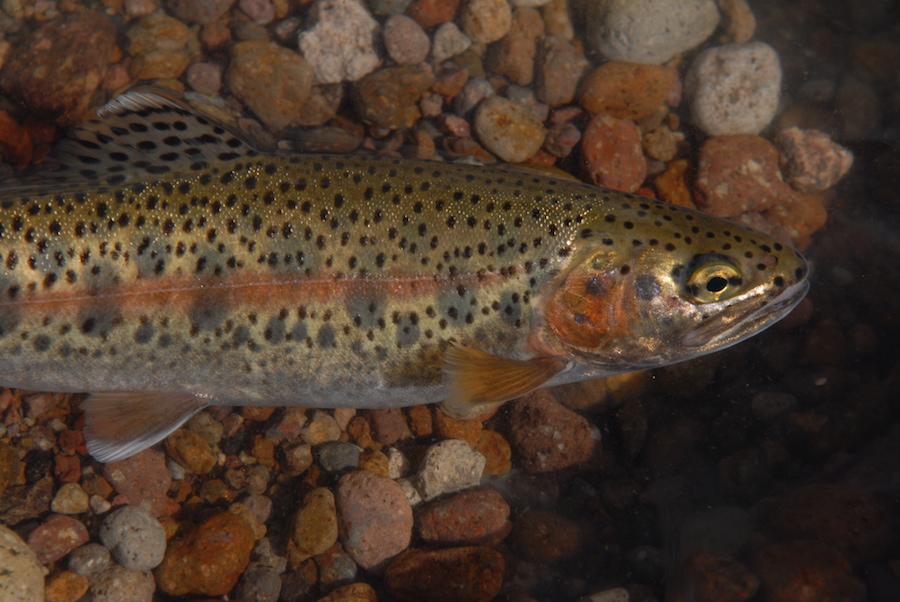
Population diversity key to salmon resiliency
A recent report commissioned by California Trout — a San Francisco-based nonprofit — and completed by UC Davis reviewed the state of the 32 types of native California salmon, steelhead, trout and whitefish. The report, entitled State of the Salmonids II: Fish in Hot Water, was a follow-up to a similar report completed in 2008. The newest findings indicate that nearly half of these fish populations are in danger of going extinct within 50 years. The bull trout, one of the 32 species native to California, has been extinct since 1975.
“The big overarching threat, and the one we found threatened 84 percent of the species, is climate change,” said Dr. Robert Lusardi, a joint California Trout and UC Davis Wild and Coldwater Fish researcher and one of the authors of the paper. “The reason for that is climate change will affect and is affecting the magnitude and timing of the flow, so it’s changing what these fish are evolved to. But it also affects food web dynamics, how their food interacts, abundance [and] diversity. It can also alter species interactions.”
Salmon are coldwater fish and struggle to survive in warm waters. Certain types of salmon are anadromous, or migratory, and travel from the frigid Pacific Ocean to California rivers for development and breeding. These species are most vulnerable to dams, which can cut off their traditional migration routes and spawning grounds.
Other types of salmon stay in small watersheds higher up in the hills and mountains, where the water runs quick and chilly. Even slight warming of these sensitive waters could jeopardize entire species of inland fishes. In recent years, more precipitation has been reaching California peaks as rain instead of snow. Salmon rely on large snowpacks to slowly melt during the summer, providing the perfect coldwater brew for growth and maturation.
According to Patrick Samuel, the Conservation Program coordinator for California Trout and one of the authors of the paper, everybody plays a role in revitalizing California’s native salmon.
“Something we advocate for is trying to restore the logical function of our highly altered landscapes,” Samuel said. “We can protect our source waters, our springs, our natural reservoirs on the landscapes to help store water and keep it cold and then slowly release it during the warm summer months when the fish really need it.”
The report is hopeful in regards to potential partnerships between competing water interests in California. An ongoing observational experiment involves agricultural entities and fisheries sharing seasons of land and water use.
“We’re working with rice farmers,” Samuel said. “They flood their fields in the wintertime when they don’t need to grow rice. Juvenile salmon and steelhead have historically used those floodplain habitats to fatten up before migrating to the Pacific Ocean.”
According to Lusardi, salmon are also indicators of watershed health. When coldwater fish are unable to thrive in their traditional waters, signs point to important links in the local ecosystem weakening. A sustainable California will strive to have high-quality water, and actions can be taken to improve the health of California’s native salmonids. The goal of these interventions will be “to help them return to abundance,” Samuel said.
Climate change is the largest overarching threat to 84 percent of California’s native salmonids, but it is not the only danger facing these fish. Estuary alteration, major dams and agricultural water demands impact anadromous species, while invasive fish species, severe fires and hatcheries imperil inland species.
Certain existing dams could be removed to recreate lost floodplains for fish to develop and thrive. Future construction projects that will permanently affect waterways should be mindful of the needs of watershed to keep ecosystems healthy.
The proposed Bay Delta Conservation Plan reroutes water from above the San Joaquin Delta to huge pumps for agricultural usage and human drinking water. Scientists and wildlife experts are divided on how fish will be impacted by the construction project, which will lower the resting flow volume of the San Joaquin Delta.
Dr. Peter Moyle, associate director of the Center for Watershed Sciences at UC Davis and lead author of the paper, has mixed feelings about the project.
“If the tunnels are operated as as planned with no more water exported than is done now, the remaining water will be able to flow through the Delta in a more natural fashion, reducing the likelihood of salmon being sent to unfavorable habitats in the Delta,” Moyle said in an email interview. “In the long run, properly operated tunnels should benefit salmon, or at least not make them worse off, but I would not take any bets on it.”
Written by: George Ugartemendia — friend@theaggie.org



